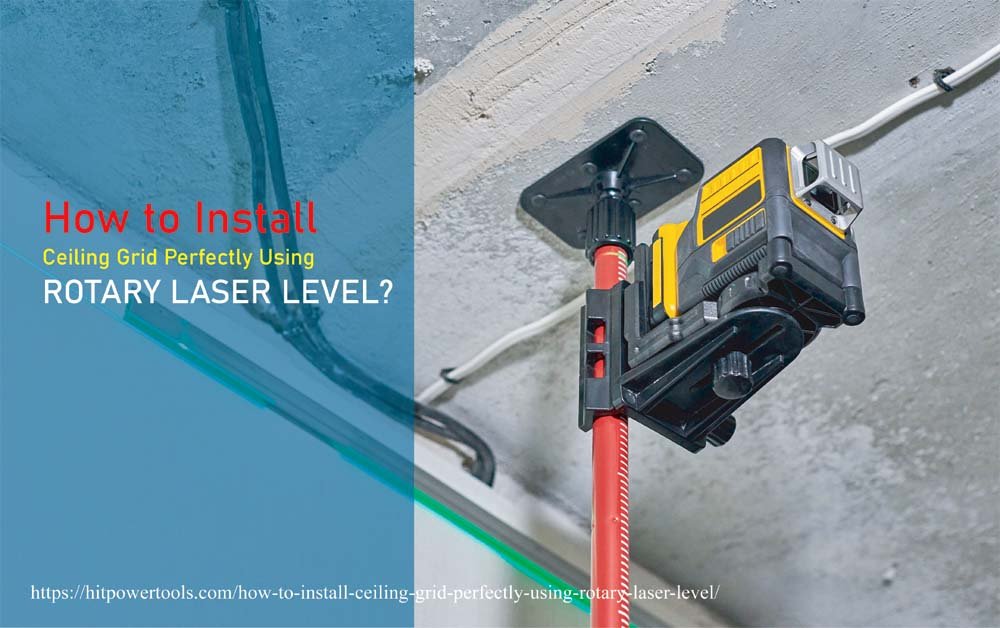How to Install Ceiling Grid Perfectly Using Rotary Laser Level? I hope you don’t know about this, While installing a new ceiling grid in your house or in your room, what should be your prime concern is accuracy. You can always try to achieve the nirvana of accuracy with chalks and markers, but the reality is, you will eventually sacrifice some proper measurements here and there.That’s where the rotary laser level comes into play. With its 360-degree beam of laser light with self-leveling technique, this device works as a real-life blueprint that you can actually walk through. If you are wondering how to install a ceiling grid perfectly using a rotary laser level, we are here to help! In this piece, we are going to explain the process in 10 simple steps so that you can start using the machine right from your next project!Let’s go! here…
What Is Rotary Laser Leveler

A rotary laser leveler is an upgraded laser leveler that can spin on its own axis at a super-fast speed that gives you an optical illusion of a 360-degree plane.
You can have planes of diverse directions – horizontal, vertical, etc. This way, you can have a 360-degree grid line around your project to eliminate using chalk and markers.
Why And How to Install Ceiling Grid Perfectly Using Rotary Laser Level
The reason you should use a rotary laser level to install a ceiling grid is accuracy. As the beam of laser surrounds the area in a 360-degree grid, it makes it absolutely a piece of cake for you to maintain the accurate measurements in setting up the ceiling grid for a perfect secondary ceiling.
How to Install a Ceiling Grid With A Rotary Laser Step By Step Guide
A well-planned and well-designed secondary ceiling can effectively hide the not-so-attractive skeleton of the main ceiling of your house. You don’t want to see the pipes and weird wires that run through the upper ceiling and keeps the water and electric service pumped up.So, you have to make sure that you are setting up the secondary ceiling at a reasonable height, not messing up with the existing wire and pipe connections.That being said, let’s find out how exactly you can set the ceiling grids first with the help of a rotary laser. Trust me; this is really fun and easy. Let’s go!
Step 1: Do Your Maths
At first, you need to do some maths before you even start gathering your tools. Take a piece of graph paper and draw the dimensions of the room or the entire area you are working on. It will give you a proper blueprint for your project.
Shorten the size of the measurement to fit into the graph paper, and it will be easier for you to draw.
Step 2: Finalize the Graph
Now that you have crafted the ceiling grid’s measurement for your project, you need to ensure that you are marking the necessary points on the graph paper.
Your project will become much more convenient to work on if you have the grid requirement and the room dimension in the same alignment properly.
Step 3: Measure the Height of the Ceiling
At this point, you have to measure the distance between the top wall and the secondary ceiling you are going to place. In the case you have a ceiling roof in your room, it will be much more convenient for you to measure the gap. However, you can basically maintain a 4-inch gap, which is a usual measurement.
Step 4: Further Measurement
Now, you need to do some further measurements. Accurately measure the gap between the ceiling beams and the specific position where you want the point.
Try to leave a dark and deep mark that can be easily identified and visible from a distance. It will help you to set up the rotary laser machine.
Step 5: It’s Time for The Rotary Laser!
Okay, so now it’s time to use the rotary laser machine! In case you don’t want to mess it up, try to get the best rotary laser machine you can. Take the machine and aim it on the floor. Place it pointing towards the deep mark that you have left on the ceiling.
Step 6: Turn the laser on!
It’s time to turn the laser light on! Start with turning the horizontal projection light on. After that, try to level the machine’s laser level as per your need. Keep doing it until the laser beam gets aligned with the wall mark that you have made a few steps before. Remember, you can’t simply make any mistake at this point.
Try to be as accurate as possible while setting this thing up. If you are not setting it accurately, it will result in a disaster after you install the grids over your head.
Step 7: Wait for the Magic!
Now, the rotary laser will show its magic. As the device is a 360-degree projector, it will take some time by rotating on its own axis. This is for self-leveling of the machine. It will take a few moments to level itself on the axis. Then, as soon as the self-leveling is done, you can see that the rotary laser has illuminated the area with straight lines both horizontally and vertically.
You can take chalk and mark the lines according to the laser light and turn it off. Or, you can keep the laser light on and work according to the laser light, too.
Step 8: Fasten the Perimeters
At this point, you need to fasten the perimeter channels that are set according to the rotary laser lines. Any channels that are there beyond the laser line, you can easily cut and trim them off and give the grids a better look.
Step 9: Level the String
Go for a finishing nail and set up a string line in the walls that are connected by the channels. Don’t forget to attach a separate line level that will make it easier to level the entire setup.
Step 10: Finalize
Finally, you need to place the cross channels that in a 90-degree position into the long-span channels. This will finalize the setup and give it a firm look And that’s how you use a rotary laser to install a ceiling grid!
The Basics of How to Use a Rotary Laser Level
Final Words
So that should explain how to install a ceiling grid perfectly using a rotary laser level. If you are following our instructions carefully, we hope it won’t be a difficult task to take on! Remember, you need to use the best rotary laser leveler to make sure you get the perfect result from such a device.
Otherwise, it will make it difficult for you, even if you are doing everything right!
Best of luck!




